Lactobacillus
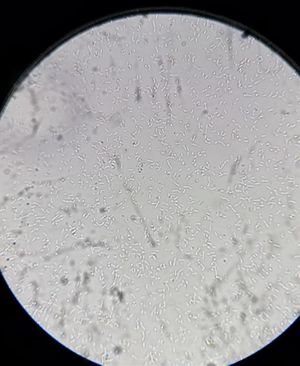
Lactobacillus (often referred to as Lacto) is a genus of Gram-positive, rod-shaped lactic acid bacteria (LAB) which produces acidity and sour flavors in the form of lactic acid (and sometimes acetic acid) found in lambics, Berliner Weiss, sour brown ales, and gueuze. All Lactobacillus species are aerotolerant anaerobes, which means they grow anaerobically but can also grow in the presence of oxygen [1]. There are more than 100 species, many of which are found in the human gastrointestinal track [2][3]. In addition to beer, some species of Lacto are also used to ferment yogurt, cheese, sauerkraut, pickles, wine, cider, kimchi, cocoa, and kefir [4]. Lacto can form a pellicle (need reference). See Pediococcus, Brettanomyces, Saccharomyces, and Mixed Cultures charts for other commercially available cultures. See the Sour Worting and Mixed Fermentation pages for brewing techniques with Lactobacillus. See the Alternative Bacteria Sources section for culturing Lactobacillus from grains, yogurt, probiotics, and other sources.
Contents
Commercial Lactobacillus Cultures
Culture Charts
| Name | Mfg# | Taxonomy | CO2 Producer (Het/Hom) | Starter Note | Fermentation/Other Notes |
|---|---|---|---|---|---|
| Brewing Science Institute | L. delbrueckii | Lactobacillus delbrueckii | A Lactobacillus bacteria that produces a clean lactic sourness. | ||
| White Labs | WLP677 | L. delbrueckii (potentially misidentified) | Heterofermentative [5][6] | no stir plate, room temp | Incubate at > 90°F and < 117°F for 5-7 days for greater lactic acid production. |
| White Labs | WLP672 | L. brevis | Heterofermentative [5][7] | No stir plate, room temp | Produced by The Yeast Bay. More hop tolerant than other Lacto strains, however TYB advises to use wort with less than 10 IBU. Temperature range: 70-95°F; 80% attenuation (this may not reflect actual attenuation of wort in a real brewery; see reference [8]). [9] |
| Wyeast | 5335 | L. buchneri | Heterofermentative [5] | 1 liter starter for a 5 gallon batch of beer, 1.020 DME sterile wort, no stir plate, no O2, starter at 90°F if possible 5-7 days | Incubate at 90°F for 5-7 days for greater lactic acid production. |
| Wyeast | 5223-PC | L. brevis | Heterofermentative [5][7] | no stir plate, room temp is fine | Heterofermentative (produces lactic acid, ethanol and CO2), more hop tolerant. Does well at room temperature. AVAILABLE ONLY FROM JULY THROUGH SEPTEMBER 2014 (Michael Dawson from Wyeast indicated that this culture may return at some point). Jamie Daly indicated on MTF that he got almost no sourness after 24 hours at 100°F (37.8°C). He lowered the temperature to 90°F-95°F (32.2°C-35°C) for 36 hours, and the pH of the wort went down to 3.29. Thus, Jamie recommends 90°F-95°F (32.2°C-35°C) for 60 hours for better souring; avoid warmer temperatures. He also aerated his starter of L. (brevis 2L starter of 1.020 dme) and set it on a stir plate at 95°F [10]. The beer wort was not aerated, and the fermenter was flushed with CO2. These methods need verification. |
| Omega Yeast Labs | OYL-605 | L. brevis, delbrueckii, and plantarum blend | Hetero/Hetero [5] | 1 liter starter for a 5 gallon batch of beer at room temperature for 24-48 hours. no stir plate | Quick souring. Pitch into 65°F-90°F. Holding temperature is not required. No longer contains delbruekii [11]. Don't use any hops if possible. 2 IBU is a good target if hops must be used [12]. |
| GigaYeast | GB110 | L. delbrueckii?[13] | Heterofermentative | Use 2 liters at 1.040 with high quality yeast nutrient. Keep as close to 86°F (30°C) as possible for 3-4 days with frequent rousing (no stir plate) [14]. | Lactic Acid Bacteria are inhibited by hops, high gravity and low temperatures. You can adjust sourness by increasing or decreasing these variables. More than 7 IBU, gravity above 1050 or temps below 65 F will increase the time to sour or lead to reduced overall souring.
We recommend brewing with GB110 in one of three ways. I) “Hot Start”: Pitch GB110 to wort at 98 F with little or no hops for 48-72 hrs. Wort may be soured before kettle boil or after. If soured before kettle boil, boil with hop additions as usual. If soured after kettle boil cool wort and pitch yeast. II) “Co-Pitch”: Pitch GB110 into a primary with yeast of your choice at 68-72 F. Wort that is less than 1050 and 7 IBU will typically be very sour in 2-3 weeks. III) “Secondary”: Pitch GB110 after primary fermentation for an aged sour. Souring by this method typically requires several months. Adding simple sugars or fruit etc. will enhance souring in the secondary [15]. Sometimes referred to as GigaYeast's "Fast Acting Lacto". This strain is hop sensitive [16]. |
| RVA Yeast Labs | RVA 600 | L. rhamnosus GG | Homofermentative | No starter necessary | Homofermentative Lacto strain found in probiotics; sensitive to hops; does well at room temperature. |
| SouthYeast Labs | Lactobacillus 1 | Unknown | Heterofermentative | Source: Spontaneously infected beer (South Carolina). Best suits Light sours, gose, farmhouse saison (medium/high acidity). | |
| SouthYeast Labs | Lactobacillus 2 | Unknown | Homofermentatative | Source: Prickly pear fruit (South Carolina). Best suits strong sours, and lambic (high acidity). | |
| Inland Island Brewing & Consulting | INISBC-991 | L. brevis | Heterofermentative | Produces more lactic acid at higher temperatures and in low hop worts. 70-95 F Temperature Range | |
| Inland Island Brewing & Consulting | INISBC-992 | L. delbruekii | Homofermentative | Produces more lactic acid at higher temperatures and in low hop worts. 70-95 F Temperature Range | |
| Inland Island Brewing & Consulting | INISBC-932 | L. fermentum | Heterofermentative |
Manufacturer Tips
Omega Yeast Labs on OYL-605
The following is a statement by Lance Shaner, owner of Omega Yeast Labs:
Lance Shaner: Full disclosure: I own Omega Yeast Labs. Pitching at 120F is a bad idea with this blend. The bug doing most of the work in this blend is Lactobacillus plantarum. The best temp for plantarum is 80-90F. It does not work [as well] over 100F. Also, we regularly make a 1 liter starter with the Lacto blend for faster souring. Simply pitch the contents of the pouch into 1 liter of sterile 1.040 wort and let sit for 24 hours at 70-80F before pitching (no need to stir). Adi Hastings mentioned the imperial stout we just kettle soured. We previously brewed a Berliner using the same method. At 17 hours, pH was at 3.42 and temp was 75F (original pitch temp was 85F). At 40 hours, pH was 3.24, at which time we boiled. Lower pH in the Berliner compared to the stout at 17 hours likely has to do with different buffering capacities in different worts.
This blend is very susceptible to hops. It is recommended to not use any hops when souring with this Lacto. If hops must be used (some commercial breweries have to use hops for legal reasons), a maximum of 2 IBU is recommended.
Wyeast on 5335
The following is an excerpt with Jess Caudill, Brewer/Microbiologist, at Wyeast Laboratories, Inc. concerning usage of Wyeast 5335 and making a Berliner Weissbier.
- Use 5335.
- If using our 5335, don’t use ANY hops. You can always blend in some IPA or hopped wort after souring takes place if you really need some bitterness or hop flavor/aroma in the beer.
- From one 5335 pack, make a 1L starter with 1.020 DME sterile wort. No O2! Incubate at 90°F if possible for 5-7 days.
- Brew your 5 gallons of wort. Again… no hops. Sterilize the wort. (No need for sour mashes). Cool to 90°F and add 1L 5335 starter. No O2. Try to maintain 90°F for 5-7 days depending on how sour you want the beer.
- After 5-7 days, cool wort to around 68. Pitch with a low pH tolerant strain such as 1007 or 2124. No O2. Ferment for around 1-2 weeks… until you hit terminal.
- Package beer. If bottle conditioning, use 4021 as a bottling strains. Very tolerant to low pH.
RVA Yeast Labs on RVA 600
A great lactic acid bacterial strain that will add a pleasant tangy sourness. RVA 600 is a pure culture of Lactobacillus rhamnosus GG which is found in many commercial probiotic products which have been shown in clinical studies to have many beneficial effects. These are homofermentative (only produces lactic acid, no carbon dioxide or ethanol) and are hop-sensitive. For more pronounces souring add before you add your yeast. You can sour to taste then add a yeast strain to outcompete the bacteria. Again, hop sensitive so easy on them…or dry hop the heck out of it! You may also want to experiment with blending sour low hop beer with an ale strain beer. [17]
... the amount of bacteria in our homebrew units should eliminate the use of a starter. Pitching on the warm side will speed up the souring but RVA 600, a pure culture of Lactobacillus rhamnosus GG, the first commercially available probiotic propagated for use in brewing, does just fine at room temp. We had originally developed RVA 600 as a mix but fell in love with the pure strain.[18]
SouthYeast Labs on Lactobacillus 1 and 2
The L2 strain grows best at 86°F-100°F (30°C-37.7°C), and does not work well over 100°F. Keep IBU's low to none. L1 will likely be discontinued due to high amounts of acetic acid production [19].
White Labs on WLP672
"It is intended for secondary, so you only need to do a starter if you are doing a primary fermentation with it. DME would be the best substrate... Since its a Lacto species, you don't really want to aerate it. A slow stir-plate would be good, to keep it moving, but not much more than that." - Sarah Neel, White Labs, Sales and Customer Service (quoted with permission).
General Advice
Starters and Pitching Rate
In addition to the starter information given in the Manufacturer Tips above, this section includes general advice for Lactobacillus starters for homebrewers and brewers. For growing Lactobacillus in a lab environment, or from an initial grouping of cells from a plate/slant or smaller cell count, MRS media is the most efficient growth media. However, for full pitches of Lactobacillus in beer/wort, brewers probably don't want to add that much MRS media to their beer since MRS media has a distinct odor and smell that would not be desirable in beer [20]. Therefore, growing Lacto in a wort-based starter media is recommended for building full pitches of Lacto. See External Resources for additional starter guides.
Pitching ~0.5-1 liter per ~20 liters of wort (~0.75-1 gallon per barrel) of Lactobacillus starter is the general guideline. The exact advisable pitching rates of commercial cultures may differ from manufacture to manufacturer. [21]. Counting the exact number of cells can be difficult to achieve due to the small size of bacteria cells, so starter volumes are generally used instead when talking about pitching rates for Lactobacillus [22].
Starter mediums that brewers have used include unhopped DME wort starters and apple juice starters. These tend to be adequate for many brewers. However, Samuel Aeschlimann from Eureka Brewing Blog showed that using DME with a little bit of apple juice, chalk, and yeast nutrients provides close to optimal cell densities that match MRS media cell densities.
Samuel Aeschlimann's Starter Procedures
Although 100% apple juice or 100% DME starters wi;l "work" for Lacto starters, they do not provide optimal growth conditions. Samuel Aeschlimann from Eureka Brewing Blog ran a set of experiments that found a DME based recipe for starter wort that produces a very high cell density similar to that of MRS media (MRS media provides optimal growth rates for Lacto). The recipe for this starter wort is: 1.040 SG (10°P) Dried Malt Extract wort with 10% apple juice + 20 grams of chalk (CaCO3) per liter + yeast nutrients. To create a 1 liter starter for 20 liters of wort, follow these directions:
- Add 100 grams of DME to around 900 mL of water and heat pasteurize/boil as you would normally do for a starter. This should make 1.040 SG (10°P) starter wort.
- Cool the DME wort to the desired incubation temperature (see step 4), and add 100 mL of pasteurized apple juice, 20 grams of chalk (CaCO3), and half a teaspoon of yeast nutrients. The chalk won't dissolve into solution, so don't worry about it. [23]. Boiling the apple juice will destroy some of its nutrients, and since it is pasteurized boiling it isn't necessary [24].
- Best practice is that starters should not be aerated, although there may be an exception to this for L. brevis [10]. Some people prefer to stir their starter with an airlock in order to keep the bacteria in suspension, others do not use a stir plate and keep the starter still. One advantage to not using a stir plate at least until the brewer is more familiar with their culture is that the top of the starter will begin to clear when the starter is done if the starter was kept still.
- The starter should be held at the temperature best suited for the culture as shown in the Culture Charts.
- Reference the above Culture Charts for how long the starter should be incubated for before pitching. If a stir plate is not used, one indication that the starter is done will be when the top of the starter begins to clear [25].
- The chalk is not desirable to pitch into the beer because of its buffering effect. The chalk will sediment within hours of being added to the starter, or if a stir plate is used, a couple of hours after the stir plate is turned off [26][25]. The Lacto should stay in suspension for at least a day or two after the starter is done, so swirling the starter isn't necessary, although it is certainly an option. If the starter is swirled, allow a couple of hours for the chalk to sediment out again. After the chalk sediments to the bottom of the flask, pour all of the liquid from the top of the starter into the wort/beer, and leave the chalk sediment behind. Avoid cold crashing the starter because it can have an adverse effect on the bacteria's health [27][23].
See Lacto Starters, by Bryan Heit of Sui Generis blog for additional information on Lactobacillus starters.
Cell Growth
"I typically grow it by itself anaerobically in MRS media. Seems to work very well and results in good growth. I've personally had the best success with MRS media and in an anaerobic environment, though I know some Lactobacillus strains grow aerobically just fine. The problem with growing lactic acid bacteria is the acid they produce will eventually inhibit their own growth. MRS contains a buffer to help combat the drop in pH as a result of LAB metabolism, which keeps the pH around 6-6.5 (I think) for optimal growth. I usually grow them at 35 C, but sometimes incubator space is at a premium (like right now) and I just [use a stir plate with an airlock]" [28]. - Nick Impellitteri from The Yeast Bay on general Lactobacillus cell growth
Hop Tolerance
- Editor's note: the following are comments by Bryan Heit of Sui Generis Brewing blog
There is a fair bit of research into hop tolerance out there; its not a simple topic as a number of factors come into play to produce hop tolerance. To make things even more complicated, hop tolerance is an inducable trait in many Lacto species - meaning that a seemingly susceptible strain can become resistant by culturing in ever-increasing doses, and a seemingly resistant strain can become susceptible after a generation or four in a hop-free media.
I've been trying to generate a permanently high-alpha acid resistant lacto strain for a few months now. I've been culturing L. brevis in escalating IBU wort (starting at 10, currently at 25). Every 4th generation (1 generation = a subculture of a stationary-phase lacto culture, not as in # cell divisions) I pass it through 2 generations of an IBU-free media to try and select for strains which maintain this resistance. This seems to have worked upto ~18 IBU, but past that point the resistance appears to remain inducable. I'm hoping a few more generations will provide me with a permanently tolerant strain.
There are some other options; I've purified (but didn't keep - doh) some pretty resistant strains from grain by by making plates where you half-fill a plate, on an angle, with a high-IBU wort, and then overlay that with a no-IBU wort. This gives you a gradient plate, with low-IBUs on the end where the hopped-wort layer is thinnest and high IBUs where it is thickest. Some of those strains were resistant to over 30IBU, but being early in my yeast farming days I didn't bother keeping those [29].
Hops contain multiple compounds which are bacteriostatic. Alpha acids are the best understood, but other compounds such as beta acids, a number of polyphenols (e.g. xanthohumol), and even some of the aromatic oils (e.g. humulene) have been found to have some inhibitory effects on lactobacilli. The later compounds (especially the beta acids) are why aged hops retain inhibitory characteristics, despite being nearly devoid of alpha acids. In all cases these compounds appear to inhibit the bacteria in the same way - all of these compounds contain fairly large, flat-ish, hydrophobic regions. These regions do not "like" to be in water, and thus will be driven into the hydrophobic core of the bacterial plasma membrane. This opens minute holes in the membrane which prevents the bacteria from maintaining ion (in particular, proton) gradients, leading to suppression of growth and even death of the bacteria.
Hop resistance is generally due to the induced expression of "multi-drug transport" (MDT) genes, which are "pumps" that recognize the general chemical signature of membrane-disruptive compounds, and then pump them out of the cell. Other mechanisms may also be involved - a few papers have identified changes in the lipid make-up of the plasma membrane, which may increase stability. This change also occurs in response to alcohol (to improve stability), so its not clear if that particular change has anything to do with hop resistance.
Lactobacilli usually don't have these MDT genes 'on', which is why a lot of strains won't do well with hops in the first batch of beer, but over time become more and more tolerant as they increase expression of the MDT's. The overall MDT expression level, in theory, determines the maximum resistance of the bacteria. In the case of my experiments, I'm looking for mutants whose MDT's are permanently stuck 'on' for the resistant strain and 'off' for the sensitive strain [30].
See also:
- How hops prevent infection, by Lars Garshol.
- Per Buer's Video Demonstration of how Dry Hopping Affects multiple Lacto species.
Storage
For dried Lactobacillus, such as probiotics or Dry Yeast for Sour Ales BlackManYeast products, Bryan Heit's lab studies have shown that they can lose viability ~80 times faster at room temperature than when stored at refrigeration temperatures. Therefore, it is recommended to store dried Lacto at refrigeration temperatures.
Liquid cultures become stressed by two factors: storage in an acidic environment, and storage without sugar [31]. Sugar storage creates more acid as the Lacto ferments it, so it may not be ideal unless the Lacto is continually fed. Ideally, liquid cultures of Lacto should be stored frozen with 20% glycerol, or refrigerated as slants with water or mineral oil. Also, there is anecdotal evidence that certain species may survive better at room temperature. Bryan hypothesizes that stable temperatures may be more important than storing at an "ideal" temperature [32].
A practical option for brewers without a laboratory is to store the liquid culture with a few grams of a buffering chemical such as calcium carbonate (chalk), potassium phosphate, calcium sulfate (gypsum), or calcium hydroxide (pickling lime). The exact amounts should be adjusted to reach a pH of about 4.0-6.0 for the entire solution (begin with 1 or 2 grams per liter, and adjust as needed) [33].
Tom Belgrano offers these additional steps in order to remove the residual sugars from a storage solution, as well as raise the pH [34]:
- Cold crash the starter until the wort is clear.
- Decant the liquid, and then refill it with water (distilled is recommended, but not required).
- Cold crash again until the liquid falls clear.
- Decant the liquid.
- Store the resulting slurry at refrigeration temperatures. A slight drop in pH may still occur, but this technique should keep the storage solution well above 4.0 pH.
Commercially available Lactobacillus strains and their pH change over time
All data provided by Matt Humbard. Similar results were reported by Lance Shaner's 100% Lactobacillus Fermentation experiment.
pH change at 86°F
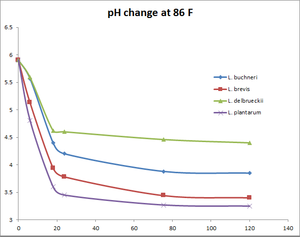
| Time (hours) | Wyeast Lactobacillus buchneri | White Labs Lactobacillus brevis | White Labs Lactobacillus delbrueckii | Omega Lactobacillus plantarum |
|---|---|---|---|---|
| 0 | 5.9 | 5.9 | 5.9 | 5.9 |
| 6 | 5.57 | 5.13 | 5.59 | 4.81 |
| 18 | 4.4 | 3.94 | 4.62 | 3.6 |
| 24 | 4.2 | 3.78 | 4.6 | 3.45 |
| 75.5 | 3.88 | 3.44 | 4.46 | 3.27 |
| 120 | 3.85 | 3.4 | 4.4 | 3.25 |
pH change at 98°F
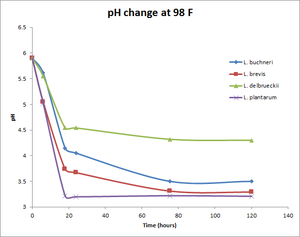
| Time (hours) | Wyeast Lactobacillus buchneri | White Labs Lactobacillus brevis | White Labs Lactobacillus delbrueckii | Omega Lactobacillus plantarum |
|---|---|---|---|---|
| 0 | 5.9 | 5.9 | 5.9 | 5.9 |
| 6 | 5.61 | 5.05 | 5.55 | 5.02 |
| 18 | 4.15 | 3.74 | 4.54 | 3.22 |
| 24 | 4.05 | 3.67 | 4.54 | 3.2 |
| 75.5 | 3.5 | 3.31 | 4.32 | 3.22 |
| 120 | 3.5 | 3.29 | 4.3 | 3.21 |
pH change at 102°F
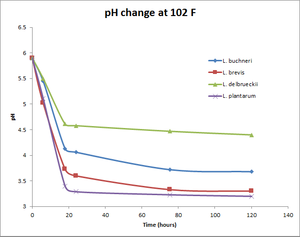
| Time (hours) | Wyeast Lactobacillus buchneri | White Labs Lactobacillus brevis | White Labs Lactobacillus delbrueckii | Omega Lactobacillus plantarum |
|---|---|---|---|---|
| 0 | 5.9 | 5.9 | 5.9 | 5.9 |
| 6 | 5.45 | 5.02 | 5.5 | 5.11 |
| 18 | 4.13 | 3.73 | 4.61 | 3.4 |
| 24 | 4.06 | 3.6 | 4.58 | 3.29 |
| 75.5 | 3.72 | 3.33 | 4.47 | 3.23 |
| 120 | 3.68 | 3.3 | 4.4 | 3.2 |
pH change at 108°F
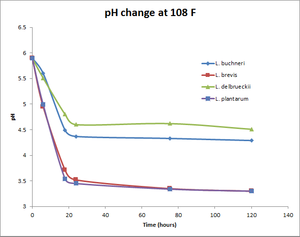
| Time (hours) | Wyeast Lactobacillus buchneri | White Labs Lactobacillus brevis | White Labs Lactobacillus delbrueckii | Omega Lactobacillus plantarum |
|---|---|---|---|---|
| 0 | 5.9 | 5.9 | 5.9 | 5.9 |
| 6 | 5.6 | 4.95 | 5.51 | 4.99 |
| 18 | 4.49 | 3.71 | 4.8 | 3.54 |
| 24 | 4.37 | 3.52 | 4.6 | 3.45 |
| 75.5 | 4.33 | 3.35 | 4.62 | 3.34 |
| 120 | 4.29 | 3.3 | 4.51 | 3.3 |
Metabolism
- Editor's note: the following section was reviewed for accuracy by MTF members Bryan Heit, Matt Humbard, Lance Shaner, and Richard Preiss.
Types of Metabolism
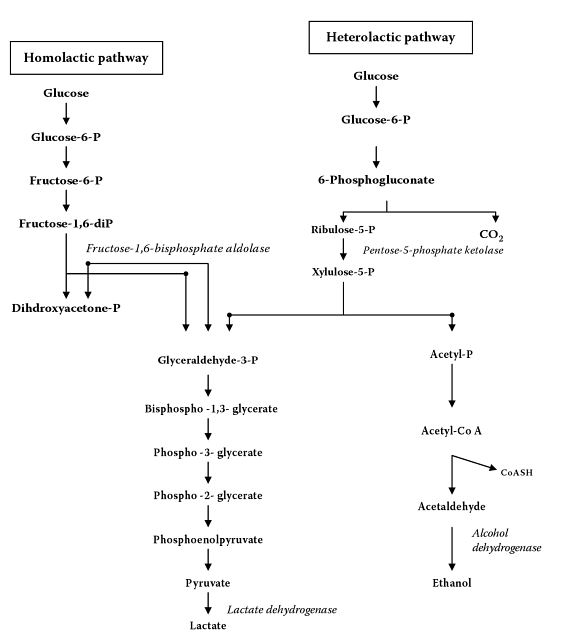
All metabolism by Lactobacillus, including growth, will require sugar to be consumed and lactate (lactic acid) to be produced. Two categories of metabolism exist, homolactic and heterolactic. In summary, homolactic fermentation produces only lactic acid, while heterolactic fermentation produce lactic acid, CO2, and ethanol/acetic acid [36].
Homolactic
Homolactic metabolism is described as the cell catabolizing one molecule of glucose to yield two molecules of pyruvate, which is then further reduced to two molecules of lactate (lactic acid). Homolactic fermentation only allows the fermentation of hexoses (glucose, mannose, etc.). Homolactic metabolism follows the Embden-Meyerhof-Parnas pathway [35].
Heterolactic
Heterolactic metabolism is described as the cell catabolizing one molecule of glucose into one molecule of CO2, one molecule of glyceraldehyde phosphate, and one molecule of acetyl phosphate. The molecule of glyceraldehyde phosphate is reduced to one molecule of lactate, and the acetyl phosphate is reduced to one molecule of ethanol (or one molecule of acetic acid instead of ethanol, depending on its growing environment [37]). Heterolactic fermentation allows the fermentation of hexoses and pentoses [38]. Heterolactic fermentation follows the pentose phosphate pathway, or also called the phosphogluconate pathway [35].
Categories of Lactobacillus
There are three categories of Lactobacillus based on the type of fermentation they are capable of (homolactic, heterolactic, or both).
- Obligatory homofermentative Lactobacillus only perform homolactic fermentation, and thus only produce lactic acid [35].
- Obligatory heterofermentative Lactobacillus only perform heterolactic fermentation, and thus produce lactic acid, CO2, and ethanol (or sometimes acetic acid instead of ethanol) [35].
- Facultatively heterofermentative Lactobacillus generally are homolactic when there is an abundance of carbohydrates, but can also perform heterolactic fermentation when carbohydrates are not abundant [35].
Other factors can determine if a facultative heterofermentative species uses homolactic or heterolactic fermentation. For example, L. plantarum, which is a facultatively heterofermentative species, is homolactic without the presence of oxygen. In the presence of oxygen, however, it performs heterolactic fermentation, and produces acetic acid [39][40].
| Obligatory Homofermentative [41] | Obligatory Heterofermentative | Facultatively Heterofermentative |
|---|---|---|
| L. acidophilus | L. brevis | L. casei |
| L. delbruekii | L. buchneri | L. curvatus |
| L. helveticas | L.fermentum | L. plantarum |
| L. salivarius | L. reuteri | L. sakei |
| L. rhamnosus [42] | L. pontis |
100% Lactobacillus Fermentation
Lance Shaner's experiment on testing 100% Lactobacillus Fermentation showed that pure cultures of WLP677, WLP672, Wyeast 5335, Wyeast 5223-PC, and the L. plantarum from Omega Yeast OYL-605, could not fully attenuate a 1.037 SG wort. The most attenuative Lacto culture, WLP677, was only able to attenuate down to 1.03255 SG. It is likely that all species and strains of Lactobacillus available to brewers cannot fully attenuate wort. In addition, this study showed at most a 0.29% ABV in 100% Lacto fermentations (attributed to WLP677). See 100% Lactobacillus Fermentation for more information. If a higher attenuation is achieved, cross contamination of yeast is most likely the cause.
The amount of CO2 produced is very small in heterofermentative species. Lance Shaner of Omega Yeast Labs noted that although L. brevis is classified as obligatory heterofermentative, the human eye cannot detect any CO2 production in the Omega Yeast Lactobacillus blend (OYL-605). Lance still needs to test this blend to see if it produces any CO2 at all. It is clear though that any type of Lactobacillus, regardless of whether it is heterofermentative or homofermentative, cannot produce a krausen. Krausens are sometimes seen with the use of commercially available Lactobacillus cultures. If a krausen develops in wort when it is the only culture that is pitched, this is indicative of cross contamination of Saccharomyces or Brettanomyces in either the wort, or the Lactobacillus culture itself [43]. In addition to this, heterolactic fermentation by Lactobacillus can only produce 10-20% of the ethanol that Saccharomyces can produce [44], therefore a high level of attenuation cannot be achieved by Lactobacillus and is again a sign of cross contamination by yeast.
Sugar Utilization and Secondary Metabolites
For a chart and in depth discussion on what types of sugars are fermentable by different species of Lactobaccilus, as well as charts on secondary metabolites, see Matt Humbard's Physiology of Flavors in Beer – Lactobacillus Species blog article. Heterofermentative species can also produce Tetrahydropyridine.
In summary:
- Different species of Lactobacillus are capable of fermenting different types of sugars, including sugars that Saccharomyces may not be able to ferment.
- All types of Lactobacillus produce different levels of secondary metabolites (compounds that are not required for the organism to live [45]) in addition to the primary metabolites discussed above. These include acetaldehyde, diacetyl, fusel alcohols, and many more compounds (see Matt's article for more details).
Foam Degradation
Some species/strains of Lactobacillus can create their own amino acids (this is to say they are prototrophic), whereas other species/strains cannot (this is to say they are autotrophic). Autotrophic Lacto can break down proteins, including foam forming proteins in beer, through a process called proteolysis [36], the breakdown of various proteins into smaller polypeptides or amino acids through the use of various enzymes [46][47][48]. Both homofermentative and heterofermentative species have been observed to have proteolytic activity [49]. This process is a large part of cheese and yogurt fermentation. Lactobacillus species that have been identified as breaking down proteins (mostly in cheese or yogurt) include Lactobacillus bulgaricus, Lactobacillus rhamnosus, Lactobacillus casei, Lactobacillus paracasei, Lactobacillus helveticus, Lactobacillus delbrueckii, Lactobacillus brevis, Lactobacillus cellobiosus, Lactobacillus fermentum, and Lactobacillus plantarum [47]. Results of using various species/strains appears to demonstrate that different species/strains are worse for degrading head retention proteins than others. For example, it's been reported that B.H. Meyer says that souring with L. delbruekii creates better head retention than souring with other species such as L. brevis. [50][51]. Different strains of the same species may also have different levels of proteolytic activity [52].
Proteolytic activity has been shown to decrease as pH falls below 5.0 for some species of Lactobacillus [47]. In order to combat poor head retention in beers that are soured with Lacto, it has been suggested by German brewing scientist, Burghard Hagen Meyer, to lower the pH of the wort to 4.5-4.8 with food grade lactic acid or phosphoric acid before pitching Lactobacillus [53][54][55]. Although the lowering of the wort's pH inhibits the proteolytic activity of Lacto, it does not stop it completely, so continued exposure to Lactobacillus over time may still degrade the available head formation proteins. Additionally, ingredients that increase head retention such as unmalted chit, malted wheat, and carafoam have been used to help combat poor head retention in beers soured by Lactobacillus [53][56]. Professional brewer Kristen England of Bent Brewstillery tested Hexa Iso Hop Extract by dosing at 4 times the recommended dosage and found that it greatly increased head retention in a Berliner Weisse (3.5% abv, pH 3.1, TA ~1, BU 5), with a minor taste difference. Kristen recommends experimenting with lower dosages to avoid too much flavor impact.
Another method that has been reported to help with head retention when Sour Worting (kettle souring) is to add a pound of DME per 5 gallons of wort during the heat pasteurization process (after the wort has been soured with Lactobacillus). One could also steep specialty grains such as wheat malt, chit malt, carafoam, or carapils, and add the extract into the kettle during the heat pasteurization or boiling process. This will add back head formation proteins that were lost during the Lacto fermentation [57][58].
See also This discussion with Gareth Young on MTF.
See Also
Additional Articles on MTF Wiki
- Alternative Bacteria Sources
- Mixed Cultures
- Mixed Fermentation
- Sour Worting
- Scientific Publications
- Pediococcus
- Hops
External Resources
- Physiology of Flavors in Beer – Lactobacillus Species - Matt Humbard's overview of different species of Lactobacillus physiology, discussion on homofermentative vs heterofermentative physiology, which species can ferment different types of sugars, and secondary metabolites. Extensive data points included.
- Beer Microbiology – Lactobacillus pH experiment - Matt Humbard's experiment to determine final pH of individual Lacto strains used in the graphs on this page.
- Lactobacillus Starter Guide by Derek Springer. - Information about starters for both pure strains, as well as culturing from grains.
- Evaluate starter media to propagate Lactobacillus sp., Eureka Brewing Blog, by Samuel Aeschlimann. - This experiment showed that growing Lactobacillus in 10°P DME, 10% apple juice + CaCO3 (20 g L-1) + yeast nutrients lead to the best growth results, and close to expensive MRS media growth results.
- Lacto Starters, by Bryan Heit of Sui Generis blog - Step by step guide to making a starter for Lactobacillus.
- Yeast terminology, part 2: bacteria, by Lars Garshol.
References
- ↑ Lactic Acid Bacteria. Todar's Online Texbook of Bacteriology. Kenneth Todar, PhD. Pg 1. Retrieved 08/09/2015.
- ↑ Lactic Acid Bacteria. Todar's Online Texbook of Bacteriology. Kenneth Todar, PhD. Pg. 4. Retrieved 07/28/2015.
- ↑ Nutrition and Growth of Bacteria. Todar's Online Texbook of Bacteriology. Kenneth Todar, PhD. Retrieved 07/28/2015.
- ↑ Lactobacillus. Wikipedia. Retrieved 07/28/2015.
- ↑ 5.0 5.1 5.2 5.3 5.4 Milk The Funk Wiki. 100% Lactobacillus Fermentation Test by Lance Shaner.
- ↑ Commercial Brettanomyces, Lactobacillus, and Pediococcus Descriptions. The Mad Fermentationist Blog. Michael Tonsmeire. Retrieved 3/4/2015.
- ↑ 7.0 7.1 Conversation with Nick Impellitteri from The Yeast Bay on the MTF Facebook Group. 3/4/2015.
- ↑ Conversation with Michael Soo and Nick Impellitteri on the Milk The Funk Facebook Group. 3/5/2015.
- ↑ The Yeast Bay website. Retrieved 3/2/2015.
- ↑ 10.0 10.1 Growth Response of Lactobacillus brevis to Aeration and Organic Catalysts. J. R. Stamer and B. O. Stoyla. Appl Microbiol. Sep 1967; 15(5): 1025–1030.
- ↑ Conversation with Raymond Wagner of Oso Brewing Co on Milk The Funk. 4/30/2015.
- ↑ Conversation with Lance Shaner on MTF in regards to IBU tolerance of OYL-605. 6/15/2015.
- ↑ From Gigayeast, Inc. on Facebook, 12/3/2014: "Appears to be L. delbrueckii."
- ↑ Personal Communication with Jim Thompson.
- ↑ GigaYeast Webpage. Retrieved 7/22/2015.
- ↑ Conversation with Steve Smith of GigaYeast on MTF. 05/08/2015.
- ↑ From RVA Yeast Lab's Website
- ↑ Discussion on Milk The Funk Facebook group with Malachy McKenna
- ↑ Conversation with David Thorton on MTF Facebook Group. 2/27/2015.
- ↑ with Lance Shaner and Nick Impellitteri on Lacto starters on MTF. 09/22/2015.
- ↑ MTF thread started by Brad Primozic. 5/29/2015.
- ↑ Conversation on MTF with Bryan Heit. 5/6/2015.
- ↑ 23.0 23.1 Evaluate starter media to propagate Lactobacillus sp., Eureka Brewing Blog, by Samuel Aeschlimann.
- ↑ Conversation with Samuel Aeschlimann and Jason Pappas on MTF about the effects of boiling apple juice. 09/24/2015.
- ↑ 25.0 25.1 Conversation with Sam Aeschlimann of Eureka Brewing Blog on MTF. 08/20/2015.
- ↑ Stokes' law. Wikipedia. retrieved 09/24/2015.
- ↑ Heit, Bryan. Lacto Starters. Sui Generis Blog. Retrieved 6/15/2015.
- ↑ Conversation with Nick Impellitteri on Milk The Funk Facebook group. 3/5/2015.
- ↑ Conversation 1 with Bryan Heit on Milk The Funk regarding Lactobacillus hop tolerance. 01/19/2015.
- ↑ Conversation 2 with Bryan Heit on Milk The Funk regarding Lactobacillus hop tolerance. 09/28/2015.
- ↑ Conversation with Bryan Heit on stress factors in storing Lacto. 09/28/2015.
- ↑ Conversation with Bryan Heit on Milk The Funk. 05/04/2015.
- ↑ Conversation with Adi Hastings on MTF. 6/20/2015.
- ↑ Conversation with Tom Belgrano on MTF regarding storing Lacto. 09/28/2015.
- ↑ 35.0 35.1 35.2 35.3 35.4 35.5 Fermentation: Effects on Food Properties. Bhavbhuti M. Mehta, Afaf Kamal-Eldin, Robert Z. Iwanski. CRC Press, Apr 12, 2012. Pg 76,77.
- ↑ 36.0 36.1 Todar's Online Texbook of Bacteriology. Kenneth Todar, PhD. Retrieved 05/06/2015.
- ↑ Lactic Acid Bacteria. Raunak Shrestha. Retrieved 6/7/2015.
- ↑ Handbook of Dough Fermentations. Karel Kulp, Klaus Lorenz. CRC Press, May 20, 2003. Pg 33.
- ↑ Lactobacillus plantarum and its biological implications. Microbe Wiki. Retrieved 6/7/2015.
- ↑ Conversation with Lance Shaner about L. plantarum on MTF. 6/7/2015.
- ↑ Lactic Acid Bacteria: Microbiological and Functional Aspects, Fourth Edition. Sampo Lahtinen, Arthur C. Ouwehand, Seppo Salminen, Atte von Wright. CRC Press, Dec 13, 2011. Pg 80.
- ↑ Complete Genome Sequence of the Probiotic Lactic Acid Bacterium Lactobacillus Rhamnosus. Samat Kozhakhmetov, Almagul Kushugulova, Adil Supiyev, Indira Tynybayeva, Ulykbek Kairov, Saule Saduakhasova, Gulnara Shakhabayeva, Kenzhebulat Bapishev, Talgat Nurgozhin, Zhaxybay Zhumadilov. 2013.
- ↑ Discussion with Lance Shaner on MTF. 6/7/2015.
- ↑ Humbard, Matt. Physiology of Flavors in Beer – Lactobacillus Species. Retrieved 6/14/2015.
- ↑ Secondary Metabolite. Wikipedia. Retrieved 6/9/2015.
- ↑ Texture, proteolysis and viable lactic acid bacteria in commercial Cheddar cheeses treated with high pressure. Cheryl Wick, Uwe Nienaber, Olga Anggraeni, Thomas H Shellhammer and Polly D Courtney. 2002. Retrieved 7/7/2015.
- ↑ 47.0 47.1 47.2 Protease Biosynthesis from Lactobacillus Species: Fermentation Parameters and Kinetics. Ikram-Ul_Haq and Hamid Mukhtar. Jan 2007. Retrieved 7/7/2015.
- ↑ Proteolysis. Wikipedia. Retrieved 7/7/2015.
- ↑ Brewing Microbiology. Fergus Priest. Springer Science & Business Media, Jun 29, 2013. Pg 133.
- ↑ Conversation with Kristen England on MTF. 7/7/2015.
- ↑ Conversation with Jace Marti on MTF about L. delbruekii head retention problems. 6/21/2015.
- ↑ Comparison of proteolytic activities in various lactobacilli. Sasaki M, Bosman BW, Tan PS. 1995.
- ↑ 53.0 53.1 Berliner Weisse – the old-time kettle-souring technique. Brewing Sour blog, by Gail Ann Williams.September 18, 2012. Retrieved 7/7/2015.
- ↑ [http://ingenuitybrew.blogspot.com/2013/06/berliner-weisse-test.html Berliner Weisse Test. Ingenuity Brew Blog. June 4, 2013. Retrieved 7/7/2015.
- ↑ 100% Lactobacillus Berliner Weisse. The Mad Fermentationist Blog, by Michael Tonsmeire. June 25, 2012. Retrieved 7/7/2015.
- ↑ Conversation with Richard Preiss on MTF. 7/7/2015.
- ↑ Conversation with Gareth Young on MTF. 05/08/2015.
- ↑ Conversation with Paul Finney on MTF in regards to head retention of Berliner Weisse. 08/29/2015.

